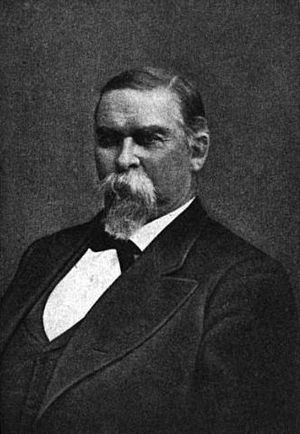John William Reid facts for kids
Quick facts for kids
John William Reid
|
|
|---|---|

Reid as depicted in Volume 3 of 1921's "Centennial History of Missouri (The Center State), 100 Years in the Union, 1820-1921".
|
|
| Member of the U.S. House of Representatives from Missouri's 5th district |
|
| In office March 4, 1861 – August 3, 1861 |
|
| Preceded by | Samuel H. Woodson |
| Succeeded by | Thomas Lawson Price |
| Member of the Missouri House of Representatives | |
| In office 1854-1856 |
|
| Personal details | |
| Born | June 14, 1821 near Lynchburg, Virginia |
| Died | November 22, 1881 (aged 60) Lees Summit, Missouri |
| Political party | Democratic |
| Spouse | Sallie Cochrane McGraw |
John William Reid (June 14, 1821 – November 22, 1881) was a lawyer and soldier. He also served as a U.S. Representative for Missouri. He was a one-time slaveholder.
Contents
Early Life and Family
John William Reid was born in 1821 near Lynchburg, Virginia. He moved to Missouri in 1840. There, he worked as a school teacher. He also studied law during this time.
Reid married twice during his life. He had children from both marriages. His first wife gave birth to a daughter, Frances, and two sons, Thomas and John H. Later, he married Sally Cochrane McGraw. They had a son named William.
John Reid's Career Journey
Reid became a lawyer in 1844. He started his law practice in Jefferson City. This was an important step in his career.
Military Service
Reid served as a captain in the Mexican War. He led a company in Doniphan's Regiment. He fought in the Battle of Sacramento. During this war, he was wounded two times.
He also took part in an expedition. This mission was against the Navajo people in New Mexico.
Political and Public Roles
After the war, Reid returned to Missouri. He became involved in local conflicts. He led groups against abolitionists in Kansas. Abolitionists were people who wanted to end slavery.
In August 1856, he led about 200 pro-slavery raiders. This event was called the Battle of Osawatomie. Later, he led pro-slavery forces in Lawrence, Kansas.
Voters in Jackson County elected Reid. He served in the Missouri House of Representatives from 1854 to 1856. He also helped to update the state's laws.
In 1856, Reid bought land near the Missouri and Kansas Rivers. This area later became Kansas City. He helped start the city's Chamber of Commerce in 1857. This group helps local businesses.
Serving in Congress
Reid was elected to the Thirty-seventh Congress. He was a member of the Democratic Party. He served from March 4, 1861, to December 2, 1861.
He was one of only two Congressmen to vote against the Crittenden–Johnson Resolution. This happened after the First Battle of Bull Run in 1861. Reid left the U.S. Congress on August 3, 1861. He was later removed from Congress on December 2, 1861. This was because he had joined the Confederate States Army.
During the Civil War, Reid volunteered for the Confederacy. He served as an aide to General Sterling Price. He also worked to settle claims against the Confederate Government.
Life After the War
After the Civil War, Reid received a pardon. This meant he was forgiven for his actions. He then returned to Kansas City.
He worked with others to build the Hannibal Bridge. This was the first bridge to cross the Missouri River. When it opened in 1869, it helped Kansas City grow. The city became a major hub for railroads.
Reid became very successful. He earned a lot of money from his law practice. He also made money from banking and real estate.
Death and Legacy
John William Reid passed away on November 22, 1881. He died in Lees Summit, Missouri. He was buried in the family vault at Elmwood Cemetery (Kansas City, Missouri).

